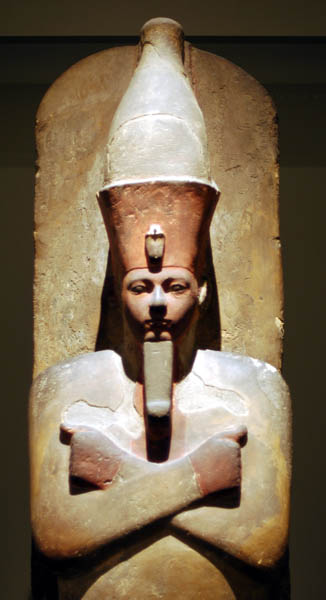|


Limestone Osiride figure of Amenhotep I,
18th Dynasty about 1510 BC, from Deir el-Bahri (west bank of Thebes).
The king is represented as Osiris.
The statue was set up a 11th Dynasty temple and its style is believed to have
been influenced by the sculptures of this earlier period.
The classic pose of Osiris
After the construction of the mortuary complex of Nebhepetre Mentuhotep
II (2055-2004 BC) in the Eleventh Dynasty (about 2125-1985 BC), the area of
Deir el-Bahri became a holy place. This statue comes from a temple set up
there by Amenhotep I (1525-1504 BC). It shows Amenhotep as Osiris. The
temple itself was probably dedicated to the particular form of the goddess
Hathor who was revered at Deir el-Bahri.
Relatively little is known about Amenhotep's temple, since it was
dismantled when Hatshepsut (1479-1457 BC) started work on her own mortuary
complex at Deir el-Bahri. A number of statues such as this were probably
placed at the entrance to Amenhotep's temple, and when the temple was
dismantled they were apparently moved to the site of the Mentuhotep temple,
where they kept company with the statues of Senusret III (1874-1855 BC),
placed there at a much earlier date.
The history of this statue is evidence of the respect sometimes shown by
one king to a predecessor when it was necessary to move a structure.
Amenhotep I, King of Egypt (1525-1504 BC)
2nd king of the Eighteenth Dynasty. He succeeded his father, Ahmose I,
who expelled the Hyksos kings from Egypt. Amenhotep I probably ascended the
throne as a child, when his mother Ahmose Nefertari may have acted as
regent. Amenhotep I and his mother, Ahmose Nefertari, were revered for
nearly five hundred years as local Theban deities.
Little is known of the reign of Amenhotep I. A few events can be
established from inscriptions in private tombs. According to the
autobiography of a soldier, Ahmose son of Ibana, Amenhotep I led a campaign
to Kush. An inscription in the tomb of Ahmose Pen-Nekhbet states that the
king also led an expedition to Libya. His chief architect, Ineni, mentions
that he commissioned building work at Karnak. The exact location of the tomb
of Amenhotep I at Thebes is unknown, but it is mentioned in the Abbott
Papyrus, which documents an inspection of the royal tombs under Ramesses IX.
Amenhotep I's mummy was found in the royal cache at Deir el-Bahri in 1881.
It was re-wrapped by priests in the 21st Dynasty, and remains the only royal
mummy which has not been unwrapped in modern times.


| |




